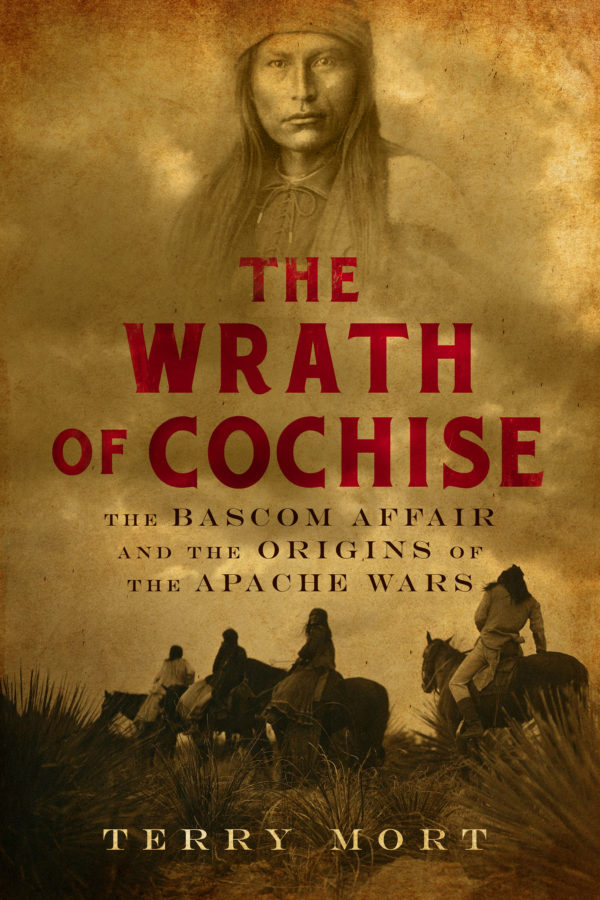The Wrath of Cochise: The Bascom Affair and the Origins of the Apache Wars
“This enthralling chronicle of cultural misunderstandings far surpasses the title’s parameters. Mort (The Hemingway Patrols) examines the 1861 kidnapping of the 12-year-old son of a white Arizona rancher, the U.S. army’s efforts to find him, and the decades of cross-cultural violence that ensued when the army blamed the wrong guy… Mort is as equally thorough in describing white society’s views of the natives as he is in illuminating the complex Chiricahuas, their precise and imagery-laden language, leadership structures, and ideas about revenge. He daringly pushes past conflicting historical records, but is always cautious to clearly signal narrative flourishes.
Beyond the thrilling tale of the kidnapping and the Apache Wars, Mort’s history is also a meditation on the metaphysical underpinnings of each belligerent’s ways of thinking, and how the differences between them contributed to the viciousness of the conflict.” — Publisher’s Weekly
![]() [SYNOPSIS] In February 1861, the twelve-year-old son of Arizona rancher John Ward was kidnapped by Apaches. Ward followed their trail and reported the incident to patrols at Fort Buchanan, blaming a band of Chiricahuas led by the infamous warrior Cochise. Though Ward had no proof that Cochise had kidnapped his son, Lt. George Bascom organized a patrol and met with the Apache leader, who, not suspecting anything was amiss, had brought along his wife, his brother, and two sons. Despite Cochise’s assertions that he had not taken the boy and his offer to help in the search, Bascom immediately took Cochise’s family hostage and demanded the return of the boy. An incensed Cochise escaped the meeting tent amidst flying bullets and vowed revenge.What followed that precipitous encounter would ignite a Southwestern frontier war between the Chiricahuas and the US Army that would last twenty-five years. In the days following the initial melee, innocent passersby—Apache, white, and Mexican—would be taken as hostages on both sides, and almost all of them would be brutally slaughtered. Cochise would lead his people valiantly for ten years of the decades-long war.Thousands of lives would be lost, the economies of Arizona and New Mexico would be devastated, and in the end, the Chiricahua way of life would essentially cease to exist.In a gripping narrative that often reads like an old-fashioned Western novel, Terry Mort explores the collision of these two radically different cultures in a masterful account of one of the bloodiest conflicts in our frontier history.
[SYNOPSIS] In February 1861, the twelve-year-old son of Arizona rancher John Ward was kidnapped by Apaches. Ward followed their trail and reported the incident to patrols at Fort Buchanan, blaming a band of Chiricahuas led by the infamous warrior Cochise. Though Ward had no proof that Cochise had kidnapped his son, Lt. George Bascom organized a patrol and met with the Apache leader, who, not suspecting anything was amiss, had brought along his wife, his brother, and two sons. Despite Cochise’s assertions that he had not taken the boy and his offer to help in the search, Bascom immediately took Cochise’s family hostage and demanded the return of the boy. An incensed Cochise escaped the meeting tent amidst flying bullets and vowed revenge.What followed that precipitous encounter would ignite a Southwestern frontier war between the Chiricahuas and the US Army that would last twenty-five years. In the days following the initial melee, innocent passersby—Apache, white, and Mexican—would be taken as hostages on both sides, and almost all of them would be brutally slaughtered. Cochise would lead his people valiantly for ten years of the decades-long war.Thousands of lives would be lost, the economies of Arizona and New Mexico would be devastated, and in the end, the Chiricahua way of life would essentially cease to exist.In a gripping narrative that often reads like an old-fashioned Western novel, Terry Mort explores the collision of these two radically different cultures in a masterful account of one of the bloodiest conflicts in our frontier history.
Introduction: Apache Pass lies between the Dos Cabezas and Chiricahua mountain ranges in southeastern Arizona. There in February, 1861, an incident occurred that started a war between the Chiricahua Apaches, on the one side, and the U.S. Army and white settlers of Arizona and New Mexico, on the other. It was not war as the whites understood it. There were no major battles in which large numbers of troops and warriors were engaged. It was a guerilla war. Attacks were often made against innocent non-combatants – on both sides. The Chiricahua effectively used their mobility and knowledge of the vast southwestern geography to frustrate the far less nimble U.S. army, so that the army’s greater manpower and firepower were nullified for much of the conflict. The first phase of this war lasted more than ten years — until 1872 — with devastating costs in lives and property. There followed a two year period of peace, but war broke out again and did not end until 1886 with the capitulation of the last remnants of the Chiricahua and their removal to a prisoner of war camp in Florida.
The broad outlines of this decades-long war are generally well known, as are the names of the principal Apache leaders – Mangas Coloradas, Geronimo, Juh, Nana, Victorio, and, perhaps most famous of all, Cochise. And it was Cochise who was there at the start of things, there in Apache Pass in 1861 when he was confronted by and, in turn confronted, a young army officer named George Bascom.
At the time of the incident Cochise was in his forties, perhaps late forties, although no one knows precisely the year he was born. He was the leader of his immediate circle, called a ‘local group,’ but he was not as yet the all powerful war chief that he would become. He had rivals among the Chiricahua – men who led their own respective local groups and who were sometimes at odds with Cochise. He also had allies, such as his father-in-law, Mangas Coloradas, who cooperated with Cochise politically and militarily. The decentralized social and political structure of the Chiricahua, and indeed of all the Apache tribes, meant that alliances and enmities often shifted according to the success in war and raiding enjoyed by one leader or another. And the Apaches were not immune to jealousies and political rivalries. A leader’s personality and rhetorical skills also affected his standing among his people and bolstered – or limited — his ability to rally other groups to his standard.
So in 1861 Cochise was one of many ‘chiefs’ and did not have the kind of political power over the wider population of Chiricahua that he would later achieve during the subsequent war against the whites. There are few contemporary accounts of him at this period, and those that exist are unflattering. Butterfield stage agent and subsequent Arizona Ranger, James Tevis, knew Cochise at this time and described him as treacherous, dangerous and untrustworthy. But Cochise successfully led his people in guerilla war for ten plus years and when he finally agreed to make peace – largely on his terms – the army officers and civilians who met him then were impressed by his gravitas, his honesty and his dignified implacability, to say nothing of the iron fisted command he exercised over his people – truly a unique situation among the independent-minded Apaches. Thus his reputation today is largely based on these later accounts – and with good reason, for he did keep his word to restrain his warriors when he made peace in 1872, and it was only after his death two years later that war broke out again. It’s fair to suggest, therefore, that the man at the beginning of the war was somewhat different from the man who ended it. Ten-plus years of fighting will change anyone. That may help to explain the inconsistencies in his story, for the barbarities he committed during the war are in sharp contrast to his statesman-like conduct and demeanor in the last two years of his life.
Whereas the reputation of Cochise has grown over the years, the reputation of his antagonist, Lieutenant George Bascom, has gone in the opposite direction. Indeed, Bascom is generally blamed for shattering the delicate relationship between the Chiricahua and the U.S. government and army. In fact, Bascom is invariably portrayed as a stereotypical young army officer whose blunders and poor judgment led to a conflict that turned out to be disastrous to the white civilians in the territory and ultimately to the Apaches, as well.
Thus the accepted history of the incident has given us the two main characters – Cochise, a leader admired for his tenacity, regal bearing and command, and George Bascom, an inexperienced officer who, when given the chance, made all the wrong decisions. There is a grain of truth in these characterizations, but as usual with binary constructions, the whole truth is rather more complicated. One of the objects of this book is to examine as much as possible the reasons the two main characters acted the way they did.
Further, the Bascom Affair, as it has come to be known, is one of those ‘footnotes of history’ that invites consideration of the larger issues surrounding the settlement of the west. Of course, the whole question of relations with the native tribes is front and center. But other large events and issues are also relevant to the story – the Mexican War, North-South politics and slavery, the impact of the Civil War, military training and strategy, the roles of mining, emigration, and transportation. In short, in the Bascom Affair we have a microcosm of, and in some ways a metaphor for, the development of the west.













